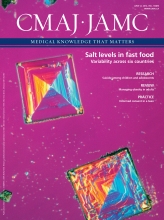Waging war against rotavirus
Rotavirus is the most common cause of severe diarrhea in infants and young children worldwide. Canada supports the Global Alliance for Vaccines and Immunisation (GAVI) in its rollout of the rotavirus vaccination campaign for the world’s poorest countries, but many Canadian provinces do not publicly fund this vaccine for Canadians. Policy-makers should ensure that all Canadian infants are offered this vaccination, say MacDonald and colleagues. See Editorial, page 1011
Suicide among young people

Image courtesy of © 2012 Thinkstock
Suicide rates are falling for boys but rising for girls, and suffocation is increasingly the method used. This descriptive study uses data from Statistics Canada spanning the period from 1980 to 2008 showing different methods of suicide and trends over time. More research is needed to understand these trends and develop initiatives to prevent suicide. See Research, page 1029
Suicide rates among children and teens are higher in regions with social and economic deprivation, such as in some Aboriginal communities. Kirmayer comments that understanding the impact of social determinants on the identities, resilience and well-being of young people in these communities may hold the key to future reductions in suicide. See Commentary, page 1015
Salt in fast food

Image courtesy of © 2012 Thinkstock
The salt content of fast foods varies substantially by the country in which the food is produced. Data on salt content were collected for foods produced by six fast food chains in six countries. In the right regulatory environment, it is likely that fast food companies could substantially reduce salt in their products, say Dunford and colleagues. See Research, page 1023
Sex ratios in Canada
Multiparous women born in India were significantly more likely than multiparous women born in Canada to have a male infant. This finding is based on male:female ratios in Ontario calculated from registry data for 766 688 singleton live births between 2002 and 2007. Whether this difference was the result of prenatal sex selection should be determined by further studies, say Ray and colleagues. See Research, page E492
Opioids for dyspnea in advanced COPD
Discrepancies between the positive experiences of patients and family caregivers with opioids and the reluctance of physicians to prescribe opioids for refractory dyspnea constitute an important gap in care, say Rocker and colleagues. See Research, page E497
Managing obesity in adults

Image courtesy of © 2012 Thinkstock
The 5A model can be useful in primary care for counselling patients who are obese or overweight. Measuring waist circumference can identify those with abdominal obesity who may have a normal body mass index. Adding psychological interventions to dietary or physical activity interventions improves their success, emphasize Plourde and Prud’Homme. See Review, page 1039
Risk of infection after splenectomy
Patients who have undergone splenectomy are at risk of overwhelming infection. Petrescu and colleagues review interventions that can be offered before and after splenectomy to substantially reduce this risk. See Practice, page 1053
Jehovah’s Witness teen with anemia

Image supplied by author
A 15-year-old girl refused transfusion for profound anemia because of her religious beliefs. Her symptoms worsened, and she ended up in the intensive care unit. What should the health care team do in this situation? See Practice, page 1055
Acute bacterial meningitis in adults
If lumbar puncture is expected to be delayed, even for neuroimaging, antibiotic therapy for acute bacterial meningitis should not be postponed, say Moayedi and Gold. The authors add that select patients can undergo lumbar puncture without prior computed tomography of the brain. See Practice, page 1060











